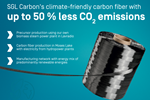SGL Carbon evaluates carbon fibers business strategy
After significant losses in 2023, SGL Carbon reviews all options for its Carbon Fibers Business Unit including a partial or complete divestment.

SGL Carbon SE (Wiesbaden, Germany) has announced that it is currently evaluating various strategic options for its carbon fibers (CF) business, including a possible partial or complete divestment of the business unit.
SGL Carbon’s carbon fibers business unit manufactures textile, acrylic and carbon fibers as well as composite materials at seven locations in Europe and North America. The company has reported that following a temporary drop in demand for carbon fibers from the wind industry market, the business unit’s sales and earnings fell significantly in the course of fiscal year 2023. In response, the company is reviewing all possibilities to support a positive further development of its carbon fibers business unit.
“After the restructuring from 2020 to 2022 and the stabilization year 2023, SGL Carbon is preparing for the next step of profitable growth,” says Dr. Torsten Derr, CEO of SGL Carbon SE. “We have positioned SGL Carbon in such a way that the four operating business units can be successful independently in their markets. In order to best exploit the development potential of our carbon fibers [business unit], we are currently evaluating all options, including a complete divestment. We are looking for a partner or new owner who can provide the necessary resources to further develop the Carbon Fibers business and position it successfully for the future.”
“As the Board of Management, it is our responsibility to make the best possible use of the company’s resources in the interests of all stakeholders to create the conditions for future profitable growth and an increase in the company’s value,” adds Thomas Dippold, CFO of SGL Carbon SE.
Related Content
-
Sulapac introduces Sulapac Flow 1.7 to replace PLA, ABS and PP in FDM, FGF
Available as filament and granules for extrusion, new wood composite matches properties yet is compostable, eliminates microplastics and reduces carbon footprint.
-
Natural fiber composites: Growing to fit sustainability needs
Led by global and industry-wide sustainability goals, commercial interest in flax and hemp fiber-reinforced composites grows into higher-performance, higher-volume applications.
-
Combining multifunctional thermoplastic composites, additive manufacturing for next-gen airframe structures
The DOMMINIO project combines AFP with 3D printed gyroid cores, embedded SHM sensors and smart materials for induction-driven disassembly of parts at end of life.













